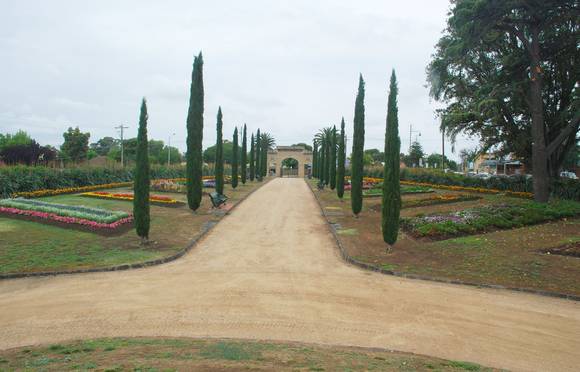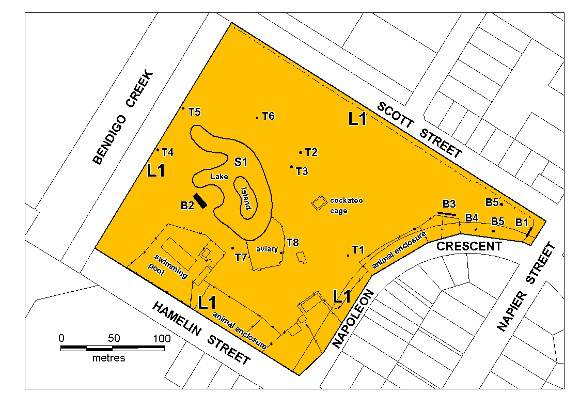| Back to search results » | Back to search page » |
|
WHITE HILLS BOTANIC GARDENS
Other NameWHITE HILLS BOTANICAL GARDENS, BENDIGO Location559 NAPIER STREET WHITE HILLS, GREATER BENDIGO CITY
File Number11/004100LevelRegistered |
|
Statement of Significance
What is significant?
A Reserve for a Botanic Garden is shown on an 1854 plan of the township of White Hills. The garden was formed around the Bendigo Creek which was later straightened to form an ornamental lake. By 1869, 266 trees had been planted, including 180 Blue Gums. In May 1870 a total of 1857 plants were recorded and another 1117 plants were ready for planting. The planting included 600 Blue Gums, 292 Pinus halepensis and 40 P. radiata. Plants had been received from Ferdinand von Mueller of the Melbourne Botanic Gardens including 20 sultana cuttings in 1871. By 1872 the gardens included a hothouse, rotunda, 200 roses, and a zoo with monkeys, koalas and birds. In 1882 there was a good collection of trees and shrubs representing the flora of every country and it was a popular place for picnics. A pavilion was built in c1910 and in 1925 an Arch of Triumph was erected at the main entrance as a memorial to those who served in the First World War. Today there is a fine collection of trees and shrubs, flower beds, animal enclosures and aviaries.
How is it significant?
The White Hills Botanic Gardens are of historical, architectural, scientific (botanical), aesthetic and social significance to the State of Victoria.
Why is it significant?
The gardens are of historical significance as one of Victoria's earliest regional botanic garden reserves. First shown on a plan of 1854, a date that coincides with legislation that allowed for municipal Councils to make bylaws for the establishment of botanic gardens. The reserve was gazetted in 1857, along with other botanic gardens at Ballarat, Malmsbury and Hamilton. Earlier Gardens had been established at Melbourne (1846), Geelong and Portland (1851) and Williamstown 1856. The Gardens are of historical significance as one of only two in Victoria (the other being the Hamilton Botanic Gardens) that still retain animal exhibits related to the acclimatization movement established in the nineteenth century.
The 1925 Arch of Triumph is of historical and architectural significance as a rare example of this building type in Victoria. The only other arches, all First World War memorials and of different designs, occur at Ballarat (1920), Murtoa (1921) and Mansfield (c1923). The Arch of Triumph is a Mannerist design with massive rusticated voussoirs and decorated with wreaths. The Arch incorporates a list of servicemen on two metal plates.
The gardens are of aesthetic significance, forming a picturesque landscape around a central lake planted with remnant River Red Gums and exotic trees. The mature conifer planting along the western boundary comprising of Pinus pinea, P. radiata, P. halepensis and individually significant P. torreyana and P. roxburghii, both rare in cultivation, is an important and prominent landscape planting. The landscape is further enhanced by an avenue of Ulmus x hollandica along the southern boundary, stands of Eucalyptus, including remnant E. camaldulensis, E. melliodora, and a cultivated E. globulus subsp. globulus. Near the main entrance are two large Ficus macrophylla and a Cedrus deodara.
The gardens are of scientific (botanical) significance for a number of rare plants and fine specimens. The Acacia karroo is rare in Victoria, only two other plants are known, at Williamstown (Holy Trinity Vicarage) and the Royal Botanic Gardens, while the only other example of Dovyalis caffra is at Werribee Park and a small plant in the Royal Botanic Gardens. The White Hills tree is the finest and largest of the species in Victoria. The Callistemon brachyandrus is an exceptionally large specimen and the Livistona australis, Juniperus virginiana, and Schinus terebinthifolius are fine specimens and uncommon in cultivation.
The gardens are of social significance for their on going use by the community for recreation and education. The Arch of Triumph is an important place of remembrance to those who served in the First World War.
Group
Monuments and Memorials
Category
War Memorial






